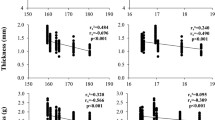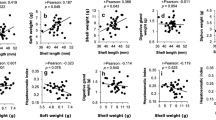Abstract
The purpose of this study was to investigate shell growth performance in two thin-shelled pelagic gastropods from cold seawater habitats. The shells of Arctic Limacina helicina and Antarctic Limacina helicina antarctica forma antarctica are very thin, approximately 2–9 μm for shells of 0.5–6 mm in diameter. Many axial ribbed growth lines were observed on the surface of the shell of both Limacina species. Distinct axial ribs were observed on the outermost whorl, while weak or no rib-like structures were observed on the inner whorls in the larger shell of L. helicina antarctica forma antarctica. For L. helicina, no ribs were observed on small individuals with three whorls, while larger individuals had distinct ribs on the outer whorls. Shell microstructure was examined in both species. There is an inner crossed-lamellar and extremely thin outer prismatic layer in small individuals of both species, and a distinct thick inner prismatic layer was observed beneath the crossed-lamellar layer in large Antarctic individuals. Various orientations of the crossed-lamellar structure were observed in one individual. Shell structure appeared to be different between the Antarctic and Arctic species and among shells of different size.



Similar content being viewed by others
References
Ahn I-Y (1994) Ecology of the Antarctic bivalve Laternula elliptica (King and Broderip) in Collins Harbor, King George Island: benthic environment and an adaptive strategy. Mem Natl Inst Polar Res Spec Issue 50:1–10
Ahn I-Y, Surh J, Park Y-G, Kwon H, Choi K-S, Kang S-H, Choi HJ, Kim K-W, Chung H (2003) Growth and seasonal energetic of the Antarctic bivalve Laternula elliptica from King George Island, Antarctica. Mar Ecol Prog Ser 257:99–110
Bé AWH, Gilmer RW (1977) A zoographic and taxonomic review of euthecosomatous pteropoda. In: Ramsay ATS (ed) Oceanic micropalaeontology. Academic Press, London, pp 733–808
Boltovskoy D (1974) Study of surface-shell features in Thecosomata (Pteropoda: Mollusca) by means of scanning electron microscopy. Mar Biol 27:165–172
Carter JG (1980) Environmental and biological controls of bivalve shell mineralogy and microstructure. In: Rhoads DC, Lutz RA (eds) Skeletal growth of aquatic organisms. Plenum, New York, pp 69–113
Comeau S, Gorsky G, Jeffree R, Teyssie J-L, Gattuso J-P (2009) Impact of ocean acidification on a key Arctic pelagic mollusc (Limacina helicina). Biogeoscience 6:1877–1882
Dame RF (1976) Energy flow in an intertidal oyster population. Estuar Coast Mar Sci 4:243–253
Fortier L, LeFèvre J, Legendre L (1994) Export of biogenic carbon to fish and to the deep ocean: the role of large planktonic microphages. J Plank Res 7:809–839
Gerhardt S, Groth H, Rühlemann C, Henrich R (2000) Aragonite preservation in late quaternary sediment cores on the Brazilian Continental Slope: implications for intermediate water circulation. Int J Earth Sci 88:607–618
Glaçon G, Rampal J, Gaspard D, Guillaumin D, Staerker TS (1994) 15. Thecosomata (Pteropods) and their remains in late quaternary deposits on the Bougainville guyot and the Central New Hebrides Island Arc1. Proc Ocean Drill Progr Sci Results 134:319–334
Griffiths CL, King JA (1979) Energy expanded on growth and gonad output in the ribbed mussel Aulacomya ater. Mar Biol 53:217–222
Hodgkinson KA, Garvie CL, Bé AWH (1992) Eocene euthecosomatous Pteropoda (Gastropoda) of the gulf and eastern coasts of North America. Bull Am Paleont 103:1–62
Hunt BPV, Pakhomov EA, Hosie GW, Siegel V, Ward P, Bernerd K (2008) Pteropods in southern ocean ecosystems. Prog Oceanogr 78:193–221
Jørgensen CB (1976) Growth efficiencies and factors controlling size in some Mytilid bivalves, especially Mytilis edulis L: review and interpretation. Ophelia 15:175–192
Lalli CM, Gilmer RW (1989) Pelagic snails: the biology of Holoplanktonic Gastropod Molluscs. Stanford Press, Palo Alto, p 259
Orr JC, Fabry VJ, Aumont O, Bopp L, Doney SC, Feely RA, Gnanadesikan A, Gruber N, Ishida A, Joos F, Key RM, Lindsay K, Maier-Reimer E, Matear R, Monfray P, Mouchet A, Najjar RG, Plattner G-K, Rodgers KB, Sabine CL, Sarmiento JL, Schlitzer R, Slater RD, Totterdell IJ, Weirig M-F, Yamanaka Y, Yool A (2005) Anthropogenic ocean acidification over the twenty-first century and its impact on calcifying organisms. Nature 437:681–686
Pakhomov EA, Froneman PW, Wassmann P, Ratkova T, Arashkevich E (2002) Contribution of algal sinking and zooplankton grazing to downward flux in the Lazarev Sea (Southern Ocean) during the onset of phytoplankton bloom: a lagrangian study. Mar Ecol Prog Ser 233:73–88
Sato-Okoshi W, Okoshi K (2002) Application of fluorescent substance to the analysis of growth performance in Antarctic bivalve, Laternula elliptica. Polar Biosci 15:66–74
Sato-Okoshi W, Okoshi K (2008) Characteristics of shell microstructure and growth analysis of the Antarctic bivalve Laternula elliptica from Lützow-Holm Bay, Antarctica. Polar Biol 31:131–138
Solomon S, Qin D, Manning M, Chen Z, Marquis M, Averyt KB, Tignor M, Miller HL (eds) (2007) Contribution of Working Group I to the Fourth Assessment Report of the Intergovernmental Panel on Climate Change. Cambridge University Press, Cambridge and New York, p 996
Steinacher M, Joos F, Frölicher TL, Plattner G-K, Doney SC (2008) Imminent ocean acidification projected with the NCAR global coupled carbon cycle-climate model. Biogeosci Discuss 5:4353–4393
Taylor JD, Layman MA (1972) The mechanical properties of bivalve (Mollusca) shell structures. Palaeont 15:73–87
Wilbur KM, Saleuddin ASM (1983) Shell formation. In: Saleuddin ASM, Wilbur KM (eds) The Mollusca 4. Academic Press, New York, pp 235–287
Acknowledgments
Sincere thanks are given to Drs. J. Shaw and I. G. Gleadall, two anonymous referees and editors for their constructive and critical reading of the manuscript. Many thanks are given to Dr. M. Sampei for providing us samples collected with sediment traps in Canadian arctic seas.
Author information
Authors and Affiliations
Corresponding author
Rights and permissions
About this article
Cite this article
Sato-Okoshi, W., Okoshi, K., Sasaki, H. et al. Shell structure of two polar pelagic molluscs, Arctic Limacina helicina and Antarctic Limacina helicina antarctica forma antarctica . Polar Biol 33, 1577–1583 (2010). https://doi.org/10.1007/s00300-010-0849-1
Received:
Revised:
Accepted:
Published:
Issue Date:
DOI: https://doi.org/10.1007/s00300-010-0849-1




